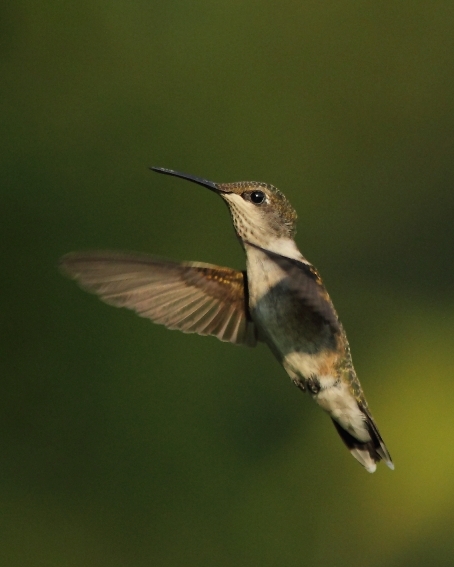Flying Jewels
Hummingbirds are enchanting. Of all the creatures that visit our gardens, these colorful “flying jewels” seem to defy gravity as they zip back and forth to lap nectar from the plants.

Photo by John McNamara, taken at our ChesLen Preserve
While there are more than 300 types of hummingbirds, the Ruby-throated Hummingbird (Archilochus colubris) is the only one that breeds in eastern North America. Both male and female have a metallic green back and crown with whitish belly and black wings. The male has a brilliant red throat patch, from which the species derives its name. An adult measures about three inches long and weighs only a tenth of an ounce—about the weight of a penny.
Their diminutive size and iridescent beauty are only part of their appeal. Even more amazing is their movement! A hummingbird’s wings can rotate 180 degrees to allow the bird to hover and even fly backwards. Those tiny wings beat about 50 to 70 times per second—just a blur of movement to the naked eye.
A hummingbird’s brain is larger, by proportion, than any other bird. These winged wonders may visit up to 1,000 flowers a day; their foraging efficiency is greatly improved by an accurate memory of which plants offer the most nectar and how recently each was visited. Hummingbirds also remember—year to year—the location of each and every nectar feeder. They can even learn which household members refill their feeders!
Hummingbirds can be attracted to your yard with a combination of feeders and nectar-producing plants. So put out a feeder or two, put a few more native plants in your garden, and enjoy the show.
- Fill your feeders with a solution of one part table sugar dissolved in four parts boiling water (cool before filling). Replace the solution weekly (more often in hot weather) and keep the feeder clean using dish soap or vinegar and rinsing thoroughly.
- While the plastic part of the feeder apparatus should be red (an attractive color to hummingbirds), do not add dye to the sugar-water content.
- Place the feeders in prominent, shady locations in the garden where you’ll be able to watch the birds as they use them.
- Hummingbirds show a preference for red and orange tubular flowers that they probe for nectar with their long beaks and extendable tongues.
- To make your yard more tempting, plant flowers in groups rather than as individual specimens and choose a broad spectrum of species (see list below) to ensure a full season of blooms.
Native Plants that Attract Hummingbirds
| Common Name | Latin Name | Season of Bloom |
| Beardtongue* | Penstemon digitalis | mid to late |
| Bee-balm* | Monarda didyma | early to mid |
| Blazing-star* | Liatris spicata | mid to late |
| Blue Vervain* | Verbena hastata | mid to late |
| Butterfly-weed* | Asclepias tuberosa | mid |
| Canada Lily | Lilium canadense | mid |
| Cardinal-flower* | Lobelia cardinalis | late |
| Columbine* | Aquilegia canadensis | early to mid |
| Common Milkweed* | Asclepias syriaca | early to mid |
| Great Blue Lobelia* | Lobelia siphilitica | late |
| Indian Paintbrush | Castilleja coccinea | mid |
| Swamp Milkweed* | Asclepias incarnata | mid |
| Trumpet honeysuckle* | Lonicera sempervirens | mid |
| Wild Bleeding-heart* | Dicentra eximia | mid to late |
* Deer resistant plant
